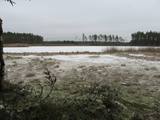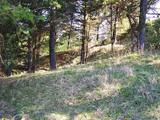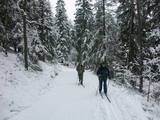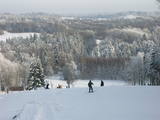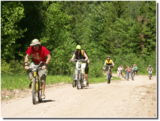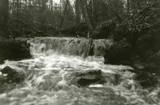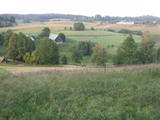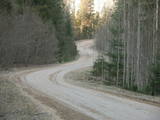| Nr | Name | Beschreibung |
|---|---|---|
|
Das ist eine der eindrucksvollsten und großflächigsten natürlichen Strukturen seiner Art in Lettland hinsichtlich Erscheinung und Landschaft. Die Eiszeit hinterließ dieses mauerartige Terrain, das bis zu 27 m hoch ist. Oben drauf wurde die Straße Rīga-Ērgļi gebaut. Die Großen Kangari – Berge bieten eine Aussicht auf den Großen Kangari – See und die Großen Kangari – Sümpfe und – Teiche. Der Ķoderi – Burgberg, auch als das “Bett des großen Mannes” bekannt, befindet sich auch hier. Das Schutzgebiet wurde errichtet, um die Struktur und seine zugehörigen Biotope und Pflanzen zu schützen.
|
||
|
Kirkas Hill in Micāni. In 1792, a small castle on the hill Priežukalns (Kirkas kalns) was rebuilt into
Lutheran Church. Nowadays, the hill still is called Kirkas kalns (in German „Kirche” means „church”).
Old people say – under the church there is a big cellar where the jewellery of church and the Mantefel
family is hidden; Manteifel family vault is there too.
|
||
|
Dieses Territorium wurde eingerichtet, um den Nesaule – Berg zu schützen, der ein bewaldeter Hügel ist und Nadel- und Feuchtwaldgebiete enthält.
|
||
|
Is an ancient Courlandian castle hill and is found in the very centre of Alsunga. It was named in 1659 when General Berg from Kurzeme put cannons on it to attack Swedish forces that had fortified themselves in the Alsunga castle. The hill is 8 to 10 metres high and 24 x 54 metres wide, offering a lovely view of the St Michael Roman Catholic Church, as well as the Alsunga windmill lake that is alongside it. There is a distinct terrace around the hill, and it once was the foundation of wooden defensive structures. On the other side of the street, to the West of the castle hill, is a cemetery with fire graves of Courlandians that date back to the 11th to 13th century. Archaeologists examined the area during the middle part of the last century. The Suiti celebrate Easter and other holidays on the hill. |
||
|
Der Naturpark von Ogre ist ein beliebter Ort für Freizeit, Wandern und im Winter für Skilanglauf. Der größte Teil des Parks ist mit Nadelwald bedeckt, der sich auf einer langen und vergleichsweise schmalen Linie von Hügeln mit steilen Abhängen befindet – ein weiteres Element der in Lettland von der Eiszeit zurückgelassenen Natur. Man findet hier viele verschiedene Pflanzen. Der Jaunogres-Burgberg ist einer der ausgeprägtesten Hügel in diesem Gebiet.
|
||
|
Befindet sich am rechten Daugavaufer, etwa einen halben Kilometer oberhalb des Landwirtschaftlichen Instituts von Skrīveri. An dieser Stelle spaltet der tiefe Graben des Baches Ašķere das steile Ufer des Daugavatals. Der Burghügel war bereits im 1. Jahrtausend v. Chr. bewohnt, hier gab es Funde, die auf Lettgalen und Liven hinweisen. Im 13. Jh. erhob sich auf dem Hügel eine steinerne Burg, die im 17.Jh. zerstört wurde. Von deren Existenz ist heute nichts mehr zu sehen. Vom Burghügel, der auch als Krähenhügel (Kraukļu kalni) bezeichnet wird, bietet sich eine der schönsten Ansichten auf den Mittelteil der Daugava. Von hier aus (in Richtung Riga) lässt sich die Stelle einer alten Kirche erkennen (ein gepflegter Platz mit einem weissen Kreuz). Am Ufer des Ašķeres Baches entlang ist ein Wanderweg eingerichtet. Die gesamte Umgebung des Berghügels ist gepflegt, insgesamt sind vier Wanderwege eingerichtet, der längste davon ist der Daugava-Pfad (10km). |
||
|
Iespaidīgs pilskalns ar izveidotu apskates taku. Blakus ūdenstūristu apmetne „Kvēpene”.
|
||
|
The castle hill of Spriņģi. It is located near Rēzekne town and it is
interesting with its peculiar shape of the ruins.Archeological monument of local significance.
|
||
|
Karņicka kalns pēc savas izcelsmes nav kalns, bet gan Daugavas ielejas nogāzes daļa ar labu skatu uz Krāslavas mazstāvu koka apbūvi. Ar šo vietu saistīts traģisks nostāsts par poļu virsnieka Josifa Karņicka un grāfa Plātera meitas mīlestību, kurai nebija lemts piepildīties tā laika „paražu” dēļ. Tā rezultātā abi nelaimīgie nolemj izdarīt pašnāvību. Virsnieks nošaujas, bet Emīliju pēdējā brīdī izglābj kalpone, neļaujot tai izlēkt pa pils logu. J. Karņicka pašnāvības vietā ir uzstādīts piemineklis. Nedaudz tālāk – rietumu virzienā guļ t.s. Austriņa akmens, pie kura 1909. gadā iedvesmojies un radījis latviešu rakstnieks Antons Austriņš. |
||
|
Der Gaiziņkalns ist der höchste Berg in Lettland und ist ein typisches Beispiel für die Hügel des Vidzemer Hochlandes. Dies ist ein Platz mit einer wunderschönen Landschaft, wenn es dort auch nicht so viele schöne Aussichtsplätze gibt. Im Zentrum des Parks befindet sich der Gaiziņkalns-Berg – die höchste Erhebung Lettlands und die zweithöchste der Baltischen Staaten (311,6 m über dem Meeresspiegel). Der Aussichtsturm ist wegen seines schlechten Zustandes leider nicht freigegeben für die Öffentlichkeit. Es gibt einen gut markierten Wanderweg um den Gaiziņkalns herum und während des Winters sind der Berg und seine Umgebung beliebt als Abfahrts- und Langlauf - Skigebiet. Der See Viešūrs (See Kaķītis) ist bei amtlich zugelassenen Fischern beliebt. Dieses Gebiet ist Teil einer Region geschützter Landschaften um Vestiena herum.
|
||
|
Lustužkalns – auf dem hohen Hügel (72
müdM) befand sich im 16 Jh. das Jagdschloss
vom Heermeister des Ordens von Livland
Wolter von Plettenberg. Aber in der Zeit der
russischen Kaiserin Katharina wurde hier ein
Vergnügungsschloss errichtet. Daher kommt
auch der Name vom Schloss und die
Erzählung der im Valguma See versenkten
goldenen Kutsche.
|
||
|
Krāču Hügel – eine Reihe von welligen Hügeln,
die sich während der Zeit vom Litorinischen Meer bei
starkem Wind gebildet haben. Von den Krāču Hügeln
ergibt sich ein wundervoller Blick auf den Liliensee.
Gegenüber vom See, am östlichen Teil der
genannten Straße, kommt man über Dolomitstufen
bis zum Denkmal für 90 lettische Schützen die 1 91 7
in Kämpfen gefallen sind.
|
||
|
Arī Senču pilskalns, Baznīckalns un Velna gulta. Pirmo reizi minēts 1230. gadā kā viens no senās kuršu zemes Vanemas centriem. Ar šo objektu var sākt Abavas senlejas skaistāko skatu apzināšanu. Līdz pilskalna plakumam ved kāpnes, un no tā redzami senlejas vārti un upes ielejas kreisā krasta nogāze, kuras piekājē izvietojusies Jaunkandava.
|
||
|
Hier gibt es einige “canyon-ähnliche” Schluchten zwischen den Dolomitablagerungen. Man findet interessante Aufschlüsse und kleine Wasserfälle im kleinen Flussbett.
|
||
|
Sens pilskalns Abavas kreisā senkrasta nogāzē. Pēc sena nostāsta zviedru karavīri ar savām cepurēm to sabēruši virs sava ģenerāļa kapa. Tagad Zviedru cepures apkārtnē ziemā var braukt pa kalnu slēpošanas trasēm, bet vasarā – ar rodeļiem.
|
||
|
Sarkanās klintis savu vārdu ieguvušas pateicoties sarkanajiem iežiem. Tieši sarkanā ir mīlestības krāsa, tāpēc sarkanās klintis ir romatiska pastaigas vieta mīlniekiem. Smilšakmens klintīs redzamas plaisas, kas sašķeļ sarkanīgos iežus, radot neparastu dabas mākslas darbu. To virsma ir diezgan izrobota, kas veido klintīs nelielas alas un nišas. Sarkanajās klintīs ir arī daudz dažādu avotiņu. Pazīstamākais no tiem ir Rūcamavots. Tam ir šāds nosaukums, jo tas, nākot ārā no zemes, izdod nelielu rūkoņu. |
||
|
Dieses Territorium schützt die höchsten Erhebungen im Alūksne – Hochland, den Dēliņkalns – Berg, sowie seine Biotope an seinen Hängen. Die örtliche Landschaft ist auch geschützt. Es gibt hier Abfahrtsski – Routen und seine südliche Seite ist besonders reizvoll.
|
||
|
The castle hill of Milka is situated near Lake Sālaja and River Malta; 27m above the lake level. Local
businessman cleaned the hill and placed the statue of Mother of God there. It is a a symbol of Latgalian
strong faith into God and Virgin Mary.
|
||
|
Atrodas ~ 1,5 km ziemeļos no Krāslavas centra, Jāņupītes krastā (ir norāde). Pēc atsevišķiem savrupatradumiem var spriest, ka pilskalns apdzīvots laikā no I g. t. pr. Kristus līdz vēlajam dzelzs laikmetam. Domājams, ka savu nosaukumu tas ieguvis šeit sastopamo mālu dēļ. Nelielas mālu ieguves vietas pilskalna nogāzēs ir redzamas arī šodien. Saglabājies nostāsts, ka grāfs Plāters šeit apraudājis savu sievu, kuru pats neuzticības dēļ licis iemūrēt pazemē. |
||
|
Dieses Gebiet ist kleiner als die Großen Kangari – Berge, ungefähr 10 km lang und 16 m hoch. Es befindet in der Nähe des Buļļi – Sumpfes. Das Territorium soll die Struktur, den Sumpf und die verschiedenen Waldarten und seltenen Pflanzen, die es in diesem Gebiet gibt, schützen.
|
||
